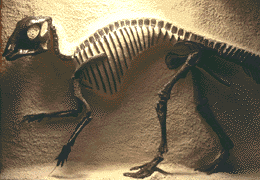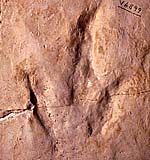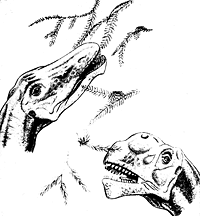



Dinosauria: Life History & Ecology
If the diverse and numerous dinosaurs (except birds) are extinct, how can we better understand how they lived? Even though the great dinosaurs of the Mesozoic are gone, they have left us many clues. Dinosaur fossils are not limited to bones, but include skin, eggs, nests, footprints, and other special kinds of fossils that give us clues about their lifestyles.
Dinosaur nests
|
|
 |
The news has recently carried several stories of wonderful finds of nesting dinosaurs, and it is true that an explosion of data on dinosaurian nesting and social behavior has been uncovered in the past 20 years. Some of the most well known and compelling evidence comes from Jack Horner's (Museum of the Rockies) ongoing work at the "Egg Mountain" site in Montana, where he has documented evidence of a large nesting area used by hadrosaurian (duckbilled) dinosaurs. These dinosaurs were named Maiasaura, "good mother reptile," referring to the closely packed nests that contain fossilized eggs, embryos, and juveniles (such as the one pictured at right). This is one case where we can be fairly confident that parental care was involved in these dinosaurs' lifestyle. Actually, this is not a surprising assertion, because both crocodilians (their closest living relatives) and birds (their living descendants), both show some degree of parental care and extensive nest building.
Other dramatic finds of dinosaur nests include theropod dinosaurs (Oviraptor and Troodon) that apparently died while brooding their nests, and abundant nests of the early ceratopsian dinosaur Protoceratops. An interesting story about Oviraptor: the so-called "egg stealer" was so named because it was found atop a clutch of eggs that were assumed to belong to Protoceratops. This idea held for some 70 years until a find in the 1990s showed an Oviraptor embryo inside one of those eggs..."egg stealer" exonerated!
Dinosaur footprints
|
|
 |
We know of literally thousands of non-avian dinosaur footprints scattered around the globe, from Late Triassic to Late Cretaceous age. You might not think that a footprint or a sequence of footprints (called a trackway) could tell us much, but actually it can tell us some general things about the biology of dinosaurs.
From trackway data, we can tell that:
- Some non-avian dinosaurs travelled in large groups;
- Non-avian dinosaurs moved with their feet held underneath their body (as birds and mammals do); and
- Some non-avian dinosaurs moved rather quickly, but some plodded along at a more leisurely pace — see our section on dinosaur speeds for more info.
Dinosaur diet
Dinosaurs, living and extinct, have varied diets. We have some strong evidence of exactly what the diets of some of the extinct dinosaurs was, and we can observe birds directly to learn about their diets. Dentition (tooth structure) is one of the most abundant lines of evidence useful for determining dinosaur diets. Most ornithischian and sauropodomorph dinosaurs had rather simple, short stubby crenellated teeth, which are similar to those of living herbivores, and clearly not too good for eating much meat.
|
|
 |
Theropod teeth, on the other hand, retain the primitive archosaurian characteristic of being recurved, serrated, laterally -compressed, and knife-like. There is some variation in tooth structure among extinct theropods, but most are fairly similar and obviously related to a carnivorous diet.
Stomach contents are another line of evidence, somewhat more direct but also a bit trickier to interpret accurately. Well-preserved dinosaur skeletons sometimes have traces of apparent food items preserved in their abdominal cavity, where it's safe to assume that they had a stomach. This includes pine cones and/or needles in some herbivores' guts, and traces of some vertebrates in some theropods' guts. So this independent line of inquiry substantiates the data from tooth morphology. Also, some sauropodomorph stomachs contain well- rounded stones, caled gastroliths, that were probably used to grind food in a muscular crop or gizzard, like some birds (and crocodilians) do.
The general hypothesis that most ornithischians and sauropodomorphs were largely, if not completely herbivorous, and that theropods (at least before the origin of birds) were mostly carnivorous, thus holds. More specific hypotheses have been proposed and supported by data, while others have fallen by the wayside. It is likely that new discoveries will illuminate more about dinosaur diets as the global "dinosaur renaissance" continues.
You can learn more about the diets of sauropods from our page on that subject.